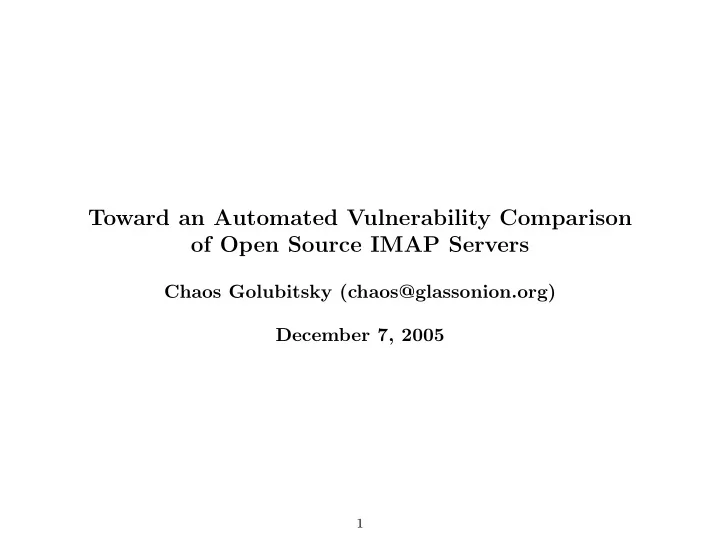

Toward an Automated Vulnerability Comparison of Open Source IMAP Servers Chaos Golubitsky (chaos@glassonion.org) December 7, 2005 1
Overview • Motivation • Attack surfaces • IMAP server design • Automated attack surface measurement • Results 2
Why automated vulnerability comparison • Goal is to minimize vulnerability of installed software • But how do we measure future vulnerability? – Past bugs? – Reputation? – Look at the code? • Useful metric must: – Be easy to apply – Give simple and usable results 3
Why analyse IMAP servers • Protocol for remote authenticated e-mail access • Three popular servers: UW, Cyrus, Courier • Prior vulnerability data is inconclusive: – Approximately 30 IMAP server vulnerabilities recorded – Almost all are remote API buffer overflows allowing arbitrary code execution 4
Analysis methodology: attack surfaces • Methodology for generating metrics • Two prerequisites for an attack on a system: – Before attack, attacker must be able to affect the system in some way – Attack must increase attacker’s access to the system • Measure system attackability by counting ways to affect the system • What do attack surface elements look like? 5
The attack surface of an IMAP server 6
IMAP design choices which affect attackability • Permissions and authentication: – Imapd account (Cyrus) vs. root/user (UW, Courier) • Subset of functionality which is built in: – Needs external network listener (UW) – Custom tcpwrappers workalike (Courier) – Custom procmail workalike (Cyrus) • How do we rigorously measure the effects of all these choices? 7
Measuring attackability: using the source • Metric used: a weighted count of the code functions available through the IMAP network interface • Weighting: not all functions are equally accessible • Access rights: – Authorization needed to execute the code – Unauthenticated, anonymous, user, administrator • Privileges: – Power the operating system gives to the running code – nobody, user, imapd, root 8
How to automatically count and classify functions • Use a code analysis tool to find all reachable functions • Starting from main() , manually divide code by privilege/access • Finding privilege/access boundaries: – Privilege: look for setuid()/setgid() calls – Access rights: password checks? internal variables? • Output: set of functions accessible at each privilege/access level 9
From sets of functions to an attackability value • Assign a weight to each privilege and access level: – More privileged functions have higher weight: ∗ weight( root ) > weight( nobody ) – Functions with more access restrictions have higher weight: ∗ weight(authenticated) > weight(unauthenticated) • Choose a simple attackability function satisfying: – Higher privilege leads to higher attackability – Higher access restriction leads to lower attackability weight(priv( f )) � Attackability(codebase) = weight(access( f )) f ∈ functions 10
Results and Discussion Courier outperformed others significantly, while UW and Cyrus tied • Metric rewards privilege separation heavily: – Courier designed to have good privilege separation – Cyrus contains more code than UW, but scored similarly • Results can depend on specific numerical weights chosen: – Cyrus imapd account vs. UW root/unprivileged user – Imapd almost as privileged as root? UW wins – Imapd barely more privileged than user? Cyrus wins • Still needed: better automation, comprehensiveness • As implemented, attackability metric gives some sensible results 11
Questions? Toward an Automated Vulnerability Comparison of Open Source IMAP Servers Chaos Golubitsky (chaos@glassonion.org) December 7, 2005 12
Recommend
More recommend